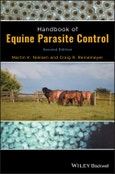Handbook of Equine Parasite Control, Second Edition offers a thorough revision to this practical manual of parasitology in the horse. Incorporating new information and diagnostic knowledge throughout, it adds five new sections, new information on computer simulation methods, and new maps to show the spread of anthelmintic resistance. The book also features 30 new high-quality figures and expanded information on parasite occurrence and epidemiology, new diagnostics, treatment strategies, clinical significance of infections, anthelmintic resistance, and environmental persistence.
This second edition of Handbook of Equine Parasite Control brings together all the details needed to appropriately manage parasites in equine patients and support discussions between horse owners and their veterinarians. It offers comprehensive coverage of internal parasites and factors affecting their transmission; principles of equine parasite control; and diagnosis and assessment of parasitologic information. Additionally, the book provides numerous new case histories, covering egg count results from yearlings, peritonitis and parasites, confinement and deworming, quarantine advice, abdominal distress in a foal, and more.
- A clear and concise user-friendly guide to equine parasite control for veterinary practitioners and students
- Fully updated with new knowledge and diagnostic methods throughout
- Features brand new case studies
- Presents 30 new high-quality figures, including new life-cycle charts
- Provides maps to show the spread of anthelmintic resistance
Handbook of Equine Parasite Control is an essential guide for equine practitioners, veterinary students, and veterinary technicians dealing with parasites in the horse.
Table of Contents
Preface to the First Edition ix
Preface to the Second Edition xi
Acknowledgements xiii
Section I Internal Parasites and Factors Affecting Their Transmission 1
1 Biology and Life Cycles of Equine Parasites 3
2 Pathology of Parasitism and Impact on Performance 25
3 Environmental Factors Affecting Parasitic Transmission 45
4 Host Factors Affecting Parasite Transmission 55
5 Parasite Factors Affecting Transmission 61
Section II Principles of Equine Parasite Control 69
6 Decreasing Parasite Transmission by NonÂ]chemical Means 71
7 Pharmaceutical Approaches to Parasite Control 81
Section III Diagnosis and Assessment of Parasitologic Information 99
8 Anthelmintic Resistance 101
9 Diagnostic Techniques 113
10 Detection of Anthelmintic Resistance 141
11 Evaluating Historical Information 149
12 Synopsis of EvidenceÂ]Based Parasite Control 155
Section IV Case Histories 163
Case 1: Mystery Drug 165
Case 2: Pyrantel Efficacy Evaluation 167
Case 3: Egg Count Results from Yearlings 169
Case 4: Peritonitis and Parasites 173
Case 5: Confinement after Deworming 177
Case 6: Abdominal Distress in a Foal 179
Case 7: Quarantining Advice 181
Case 8: Diarrhea and Colic 183
Case 9: Foal Diarrhea 187
Case 10: Oral Lesion 191
Case 11: Skin Lesion 193
Case 12: Legal Case 197
Case 13: Repeated Egg Counts 199
Case 14: Repeated Colic 201
Case 15: Ivermectin Efficacy 205
Case 16: Anthelmintic Treatments in Foals 207
Case 17: Ivermectin Egg Reappearance 209
Case 18: Name That Worm 211
Case 19: Parasite Control for Yearlings 213
Case 20: Reaction to Treatment 215
Case 21: Anthelmintic Toxicosis? 217
Case 22: Deworming Program Adjustment? 219
Glossary 221
Index








